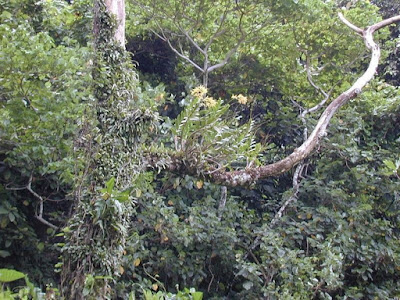Dendrobium tokai is found in Fiji and Tonga. It grow in dense and open forest at elevations of sealevel to 800 meters above sea level.
Dendrobium tokai also called as The Toka Dendrobium, Durabaculum tokai, Grastidium tokai, is a species of the genus Dendrobium. This species was described by Heinrich Gustav Reichenbach in 1865.
IDENTIFY DENDROBIUM TOKAI ORCHID PLANT
Dendrobium tokai is found in Fiji and Tonga. It grow in dense and open forest at elevations of sea level to 800 meters above sea level.
It is a medium sized, hot to warm growing epiphyte with fleshy, cylindrical, many ridged, about 3 feet stems carrying 2 apical, narrowly oblong, leathery, bilobed apically, 3 to 6 inches long, 1 to 1 1/2 inches wide leaves.
The Toka Dendrobium blooms in the fall on a 30 cm long, densely several to many flowered inflorescence arising from the nodes near the apex of the stem and carrying the 8 to 20 flowers in the upper half. The flowers are straw coloured. The labellum is an inch in length, and 2 inches wide in the front of the middle lobe. The margins are slightly undulated. In colour it is a dirty white, veined with purple.
DENDROBIUM TOKAI ORCHID PLANT CARE AND CULTURE
Cultural information should only be used as a guide, and should be to be adapted to suit you. Your physical location; where you grow your plants, how much time you have to devote to their care, and many other factors, will need to be taken into account. Only then can you decide on the cultural methods that best suit you and your plants.
Light:
Dendrobium tokai like plenty of light, but cannot stand the full noonday rays of the sun (15000-40000 lux, filtered or diffused light is recommended.). These usually do best when placed so that they can get the early morning sun, but are shaded from about 10 a.m. onwards in the Summer time. In the Winter they can usually stand the sun's rays up to 11.30 a.m.
Temperature:
The average temperature of the summer day is 25-26 ° C, night 21 ° C, giving a daily difference of 4-6 ° C. In winter, the average day temperature is 27-30 ° C, night 16-17 ° C, giving a daily difference of 13 ° C.
Humidity:
The Toka Dendrobium need the humidity of 80-90% throughout the growing period (i.e. from the time the first shoots of Spring show themselves until the last pseudobulb in Summer has grown to its maximum). In winter, the humidity drops to 65%.
Too dry air has a negative effect on the development of the plant: its growth is inhibited, and the leaves begin to turn yellow and dry out. The higher temperature, the higher the humidity should be, and the higher the humidity, the more often and longer it is necessary to ventilate the room where the plants are contained, otherwise the probability of rotting and various kinds of fungal diseases.
Substrate, growing media and repotting:
Dendrobium tokai grows best in pots with staghorn peat as substrate (crocks and charcoal at the bottom of the pot). After potting, keep the plant in a cool, shady place for a few days before placing it in its growing position. Do not overpot. Use the smallest pot that will accommodate your plant.
It does not need frequent repot, therefore, it is desirable to transplant only when it is really necessary, for example, in cases of strong salinization or compaction of the substrate, at its critically high or low pH (the norm is from 5.5 to 6.5) or when the plant grows very strongly and the pot becomes cramped to it (pseudobulbs begin to hang from the edges of the pot). Repotting is best done immediately after flowering when new roots and new growth begin to grow.
Watering:
Water must be literally poured on throughout the summer season right up to the time when the season's growths have reached full development; with the coming of autumn the quantity of water should be appreciably diminished, but this plant should not be allowed to dry out, and even in midwinter watering should be continued by giving the compost a good soaking once a fortnight-choosing a bright, clear morning for the purpose.
Watering is directly dependent on the temperature of the content, the higher it is, the more often it needs to be watered. When watering, excess water should flow freely from the pot, since stagnation of water both inside the pot and in its pan can very quickly lead to rotting of the roots and the lower part of the plant.
Fertilizer:
It is recommended to use a 1/4-1/2 dose of orchid fertilizer weekly. You can use the balanced fertilizer throughout the year or from spring to mid-summer use high-nitrogen fertilizer, and then until the end of autumn high-phosphoric fertilizer to stimulate flowering.
Rest period:
Dendrobium tokai need less water in the winter, especially if they grow under the conditions of a dark, short day that occurs at moderate latitudes. They should dry somewhat between waterings, but they should not be dry for a longer period. Frequent morning fogging and rare, economical watering should allow the plant to go through a dry period of rest, while providing it with sufficient humidity. Fertilization should be reduced or eliminated until new growths appear and a more abundant spring watering begins.















COMMENTS